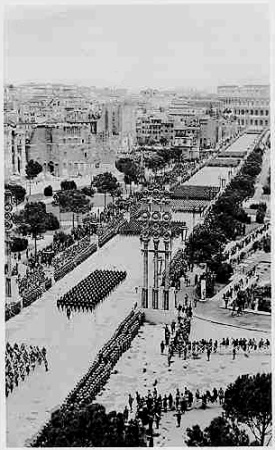| Revision as of 17:57, 19 August 2014 editAlessandro57 (talk | contribs)Autopatrolled, Extended confirmed users, Pending changes reviewers41,872 edits Undid revision 610789276 by Adriano.93 (talk)← Previous edit | Revision as of 17:40, 3 January 2015 edit undoFAM1885 (talk | contribs)Extended confirmed users6,284 edits →ReferencesNext edit → | ||
| Line 55: | Line 55: | ||
| ] | ] | ||
| ] | ] | ||
| ] | |||
Revision as of 17:40, 3 January 2015
| This article needs additional citations for verification. Please help improve this article by adding citations to reliable sources. Unsourced material may be challenged and removed. Find sources: "Via dei Fori Imperiali" – news · newspapers · books · scholar · JSTOR (August 2014) (Learn how and when to remove this message) |


The Via dei Fori Imperiali (formerly Via dell'Impero) is a road in the centre of the city of Rome, Italy, that runs in a straight line from the Piazza Venezia to the Colosseum. Its course takes it over parts of the Forum of Trajan, Forum of Augustus and Forum of Nerva, parts of which can be seen on both sides of the road. Since the 1990s, there has been a great deal of archeological excavation on both sides of the road, as significant Imperial Roman relics remain to be found underneath it.
History
The Via dei Fori Imperiali was built by order of the Fascist dictator, Benito Mussolini, from 1924-1932. The original name of the road was the Via dell'Impero. Mussolini, on horseback, cut the ribbon opening the road on April 9, 1932 and led a military parade with veterans of World War I. After the end of World War II, the road was renamed to its present name. Each year on June 2 it hosts a parade in celebration of the founding of the modern Italian Republic.
On 3 August 2013, the south part of the road, between Largo Corrado Ricci and the Colosseum, was closed to private traffic, while bus and taxi are still allowed to use it. Through December 2013, a bike path will be built.
Controversy
| This section does not cite any sources. Please help improve this section by adding citations to reliable sources. Unsourced material may be challenged and removed. Find sources: "Via dei Fori Imperiali" – news · newspapers · books · scholar · JSTOR (August 2014) (Learn how and when to remove this message) |
Although the road was touted as a celebration of the glories of ancient Rome, its construction entailed the systematic demolition of over 40,000 square yards of one of the most densely populated areas of Rome, obliterating ancient, medieval and Renaissance structures, including five churches and popular tenements that housed 746 of Rome's poorest families. These include:
- The de-consecration and stripping of the Church of Sant'Adriano in Curia Senatus (built on the Curia Julia) in the Roman Forum, to reveal the building of the senate;
- Demolition of the 17th century Convent of the Mercedari, annexed to the Church of Sant'Adriano;
- Excavation and removal of a large part of the Velia, the hill on which the Basilica of Constantine (also known as the Basilica of Maxentius) stands, half way between the Colosseum and Piazza Venezia;
- Destruction of the monastery of Sant'Urbano ai Pantani and the nearby convent of Sant'Eufemia;
- Destruction of the neighbourhood of Via Alessandrina, which included the house of famous 19th century antiquarian Francesco Martinetti, collector, restorer and numismatics expert – itself a treasure trove;
- Excavation and covering of the gardens of the 16th century Villa Rivaldi and its nymphaeums;
- Loss of several notable houses including Casa Desideri, Casa Ciacci, Casa Cetorelli and Casa De Rossi;
- Demolition of the churches of San Lorenzo ai Monti and Santa Maria degli Angeli in Macello Martyrum;
- The partial hiding of the forums of Trajan, Augustus, Caesar, and Nerva and the physical division of the units between these ruins. The via dei Fori Imperiali hid over 84% of the recently excavated forums of Nerva and Trajan;
Of the areas excavated, a great deal of data has been lost. Records at the Musei Capitolini noted that many of the objects found were stored in crates in the vaults of Museo della Civiltà Romana, but little associated data was recorded about the exact location and context of the objects, meaning that huge amounts of information that could be inferred is now irrecoverable.
The Via dei Fori Imperiali completely changed the landscape and character of the heart of Rome and sliced the Fora area in two. General outrage is often the reaction of modern archaeologists and scholars when discussing it.
Perhaps the biggest issue of all was that the now four-lane, heavily trafficked road carried an extremely heavy load of motor vehicle traffic straight through the Roman Forum area, whose exhaust fumes and vibrations continue to do immeasurable damage to the surrounding ancient Roman monuments. After numerous failed efforts by academics and citizen’s groups to convince the Roman city government to attempt to undo what Mussolini government created by removing the road, the Mayor of Roma Ignazio Marino closed the southern part of the road on 3 August 2013.
On the positive side, with Via dei Fori Imperiali has been created one of the most scenic avenues in the world, opening at the same time an important connection between the center of the city and the northeast quarter.
Sources
- Rendina, Claudio (1999). Enciclopedia di Roma (in Italian). Newton Compton.
References
- Pedonalizzazione via dei Fori Imperiali: al via il 3 agosto con una notte di festa Comune Roma Capitale
41°53′31″N 12°29′21″E / 41.89194°N 12.48917°E / 41.89194; 12.48917